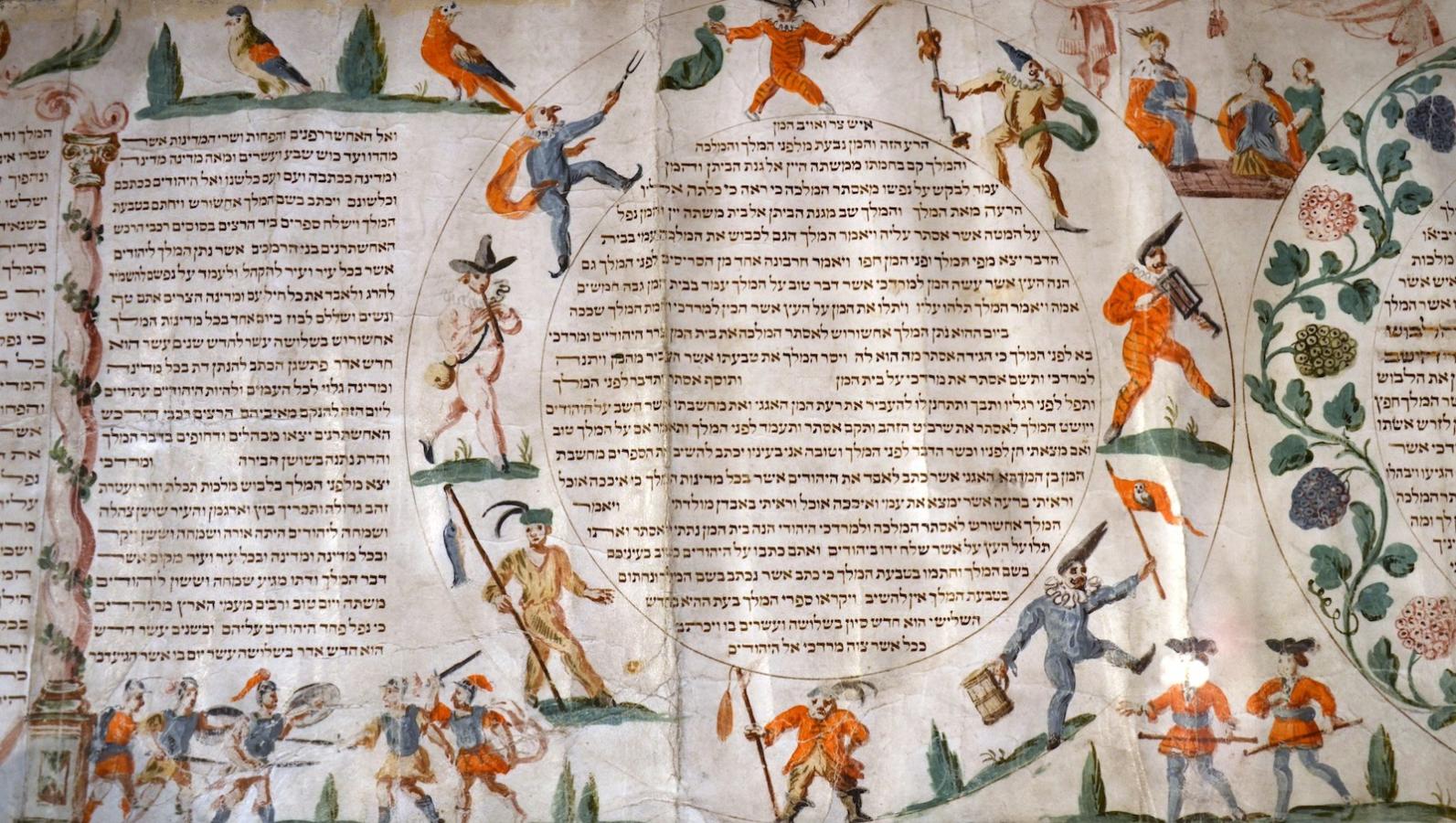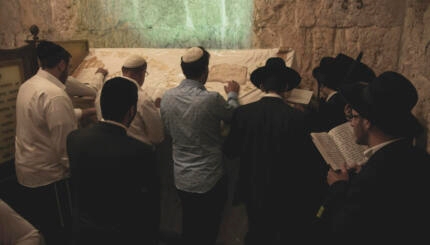The story, as told in the biblical Megillat Esther, offers a picture of a world turned upside down — in which a Jewish orphan becomes a Persian queen, the architect of a plan to kill the Jews dies at the hands of his primary target, and an assimilated diaspora community institutes a new holiday for Jews everywhere. Appropriately, the annual celebration of this upside-down-ness involves donning costumes, which allow us to be someone else for the day; the suspension of certain laws; parodies of everyone and everything; and much drinking, eating, and merriment.
At the same time as it invites lighthearted fun, the Purim story contains within it a dark side, in which the oppressed seem to become the oppressor. Megillat Esther ends with the Jews carrying out a bloody battle, in which more than 75,000 people lose their lives, and in which fear of death prompts countless others to feign Jewishness.
It is easy to regard the ending of Megillat Esther only as an exaggerated parody not meant to be taken at face value. However, this dismissal negates the extent to which this story has sometimes been understood as a justification of violence against other enemies or supposed enemies of the Jews.
The ending of the Purim story can certainly be read as a legitimate battle of self-defense in which the Jews kill those who were instructed to destroy them; indeed, this is the way that most traditional Bible commentators have understood the episode. This understanding eases concerns about the nature of the violence, but does not fully respond either to the bloodiness of the battle or to the textual ambiguity about the identity of the victims.

Help us keep Jewish knowledge accessible to millions of people around the world.
Your donation to My Jewish Learning fuels endless journeys of Jewish discovery. With your help, My Jewish Learning can continue to provide nonstop opportunities for learning, connection and growth.
A Historic Enemy
The issue of how we are to understanding the ending of the is made more complex by the fact that on the preceding Purim, Jews read parshat zakhor, the story of the defeat of Amalek, an early enemy of the Jews and the nation that produced Haman, the villain of the Purim story. This reading concludes with a command to wipe out Amalek in every generation. The juxtaposition of the reading of parshat zakhor with the reading of the megillah transforms the Purim story from a one-time event to a paradigm for using violence to respond to any opponent.
In recent years, some have likened the Palestinians to Amalek and, as such, have justified any violence against this people. It is no coincidence that Baruch Goldstein, a fanatical Jewish settler in the West Bank, chose Purim day to carry out his 1994 massacre of Palestinian worshipers in Hebron. When equated, by those of a certain political viewpoint, to the contemporary Jewish experience, the Purim story becomes an incitement to violence and not simply a satire about a distant time and place. The seriousness with which some have understood the megillah’s apparent sanction of mass murder demands that those of us bothered by the ending of the story offer an equally serious ethical response.
Seeking Explanations
A few details within the megillah challenge the traditional understanding of the battle as one of self-defense. First, the sheer number of deaths is shocking; surely, simple self-defense would not require the killing of such large numbers of people. Second, there is little suggestion elsewhere in the megillah that Haman’s feelings toward the Jews reflect the popular attitude. Indeed, the extent to which Jews appear to be assimilated into Persian society suggests quite the opposite. Even Haman’s hatred of the Jewish people is presented as an extension of his anger at Mordecai, who refuses to bow down to him, and not as abstract anti-Semitism. If other citizens of Shushan plan to participate in the slaying of the Jews, they will presumably do so out of obedience for the king’s order, and not primarily as a result of their own independent hatred of this people.
Accordingly, some commentators attempt to lessen the scale of the massacre or to restrict it to those actively involved in Haman’s plot. Addressing the verse, “And the Jews smote all their enemies with the stroke of the sword, and with slaughter and destruction, and did as they wished to those who hated them” (Esther 9:5), Malbim–Rabbi Meir Leibush (1809-1879)–distinguishes between the “enemies” whom the Jews had permission to kill and the “haters” to whom the Jews only did “as they wished.”
He writes:
Of course, the Jews were not given permission to kill anyone they wished, for it was only written in the books that they could take revenge on their oppressors… they only killed their enemies whose animosity toward the Jews was public and who threatened evil against them, but not their haters (for the difference between an “enemy” and a “hater” is that an enemy’s hatred is evident, whereas a hater’s hatred is hidden), for they only did to their haters “as they wished,” that is–they were able to rob them and to degrade them.
With this distinction, Malbim reduces the scope of the massacre to those who actively plotted against the Jews, and not to those who simply harbored a passive dislike of the people. The Vilna Gaon–or G’ra (R. Elijah ben Solomon, 1720-1797)–also distinguishes between “enemies” and “haters,” saying that an “enemy” is one who “wants to do evil himself,” whereas a hater is a bystander–one who “is happy when evil is done but who doesn’t personally do anything.”
In contrast to Malbim, the G’ra considers the bystanders in the Purim story to have suffered the same fate as the “enemies.” This reading softens the impact of the story only by emphasizing the textual comment that the Jews did not take the spoils of their victims. This restraint, the G’ra explains, indicates that the Jews carried out their massacre only in fulfillment of the king’s orders, and not for any monetary gain. At the same time, the G’ra’s condemnation of bystanders–a category with which contemporary history has made us intimately familiar–challenges us to consider our own roles as observers, if not initiators, of the widespread violence of the world.
Without protesting against the murders in Megillat Esther, the Esh Kodesh (Rabbi Kalonimus Kalmish Shapiro, 1889-1943), writing against the backdrop of the Holocaust, suggests that this type of revenge may be specific to the Purim story, and should not be expected or desired at other moments in history. Thus, he writes, in the story of Hanukkah, the villains are not killed en masse, as God does only what is necessary to free the Jews and to restore the Temple. The massacre that concludes the Purim story, he suggests, is a necessary means of ensuring the security of the Jews, and not simply gratuitous revenge.
Purim & Amalek
As indicated earlier, the story of Purim becomes most ethically problematic when read in conjunction with the command to wipe out Amalek in every generation. To reduce the extent to which the megillah can be used to condone violence in the contemporary world, we might refer to certain interpretations of the struggle against Amalek as a metaphor for an inward struggle. One passage in the Zohar, the central text of Jewish mysticism, understands Amalek as the “grave evil” that leads to dissatisfaction with one’s lot.
Similarly, a number of writers interpret Amalek as the yetzer hara–the evil instinct. The commandment to wipe out Amalek, according to these readings, cannot be used to justify a massacre such as that described by the megillah, but should instead be understood as a challenge for self-purification. Without making the megillah any less bloody, such understandings of Amalek at least reduce the Purim story to a one-time occurrence and refuse to allow it to become a model for future revenge. The suggestion that the Jews of the megillah kill only in self defense similarly precludes using the megillah as a paradigm for the way that we should act in the world.
For me, none of these attempts to lessen or to justify the deaths of more than 75,000 people fully responds to the question, well-known to us also from human history, of how an oppressed people can go on to oppress another people.
In the end, perhaps we might respond to the massacre in accordance with Esther Rabbah, the major collection of on the book of Esther. The last midrash of this collection begins with an appreciation of awe for God, who allows “the murdered to kill their murderers, the crucified to crucify their crucifiers, and the drowned to drown their drowners” (the latter being a reference to the crossing of the Red Sea) and then goes on to declare God’s abundance of mercy, loving-kindness, justice, and goodness. The midrash closes with an extended ode to peace, perhaps intended as a subtle critique of the bloodshed with which Megillat Esther itself concludes.



